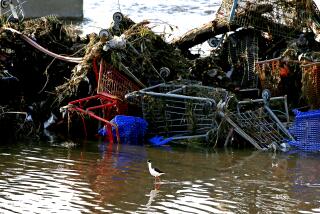U.S Cites High Selenium Levels in Wetlands, Urges New Studies
- Share via
WASHINGTON — Nine wetlands in the West, including two in California, have unusually high concentrations of selenium and should be studied further to determine whether any threat exists to wildlife, livestock or human health, an Interior Department report released Wednesday concludes.
Although the report said the sites pose “reason for concern,” it added that no evidence of “large-scale and immediate lethal effects” of selenium contamination has yet been found.
“We have no documentation that there are birds lying on the ground dead from selenium,” said Robert Broadbent, assistant U.S. secretary of the Interior for water and science.
Department officials conceded, however, that they had not done the kinds of studies that would have detected selenium toxicity in wildlife. And, the report said, selenium “seems to be accumulating” in the tissues of wintering waterfowl in California’s Imperial Valley, which was cited in the study along with the Salton Sea National Wildlife Refuge at the valley’s northern tip.
Selenium is a naturally occurring trace element that is essential to good health but harmful in large concentrations. It has killed and caused birth defects in birds at the Kesterson National Wildlife Refuge, a 1,200-acre bird sanctuary in the San Joaquin Valley. The refuge was poisoned by agricultural drainage water containing selenium.
Members of Congress asked for the report amid concerns that the poisoning of Kesterson was not an isolated case. The Interior Department ordered Kesterson closed earlier this year.
Besides the two California sites, the areas of concern cited in the study were Fallon and Stillwater national wildlife refuges in Nevada, Benton Lake and Bowdoin refuges in Montana, Poison Canyon refuge in New Mexico and Angostura and Belle Fourche refuges in South Dakota.
More to Read
Sign up for Essential California
The most important California stories and recommendations in your inbox every morning.
You may occasionally receive promotional content from the Los Angeles Times.














